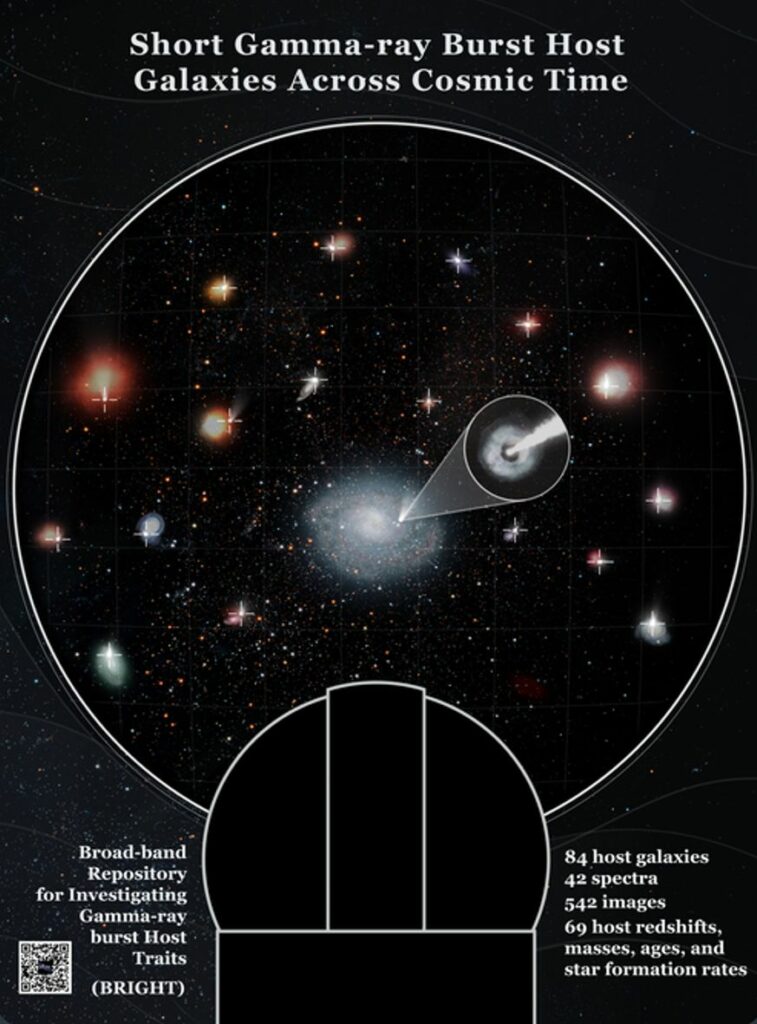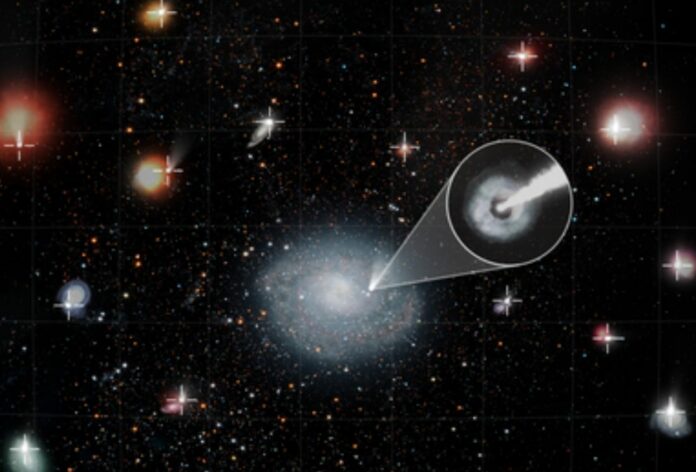The most comprehensive inventory of the universe’s brightest explosions to date pinpoints the galactic homes of 84 SGRBs and probes the features of 69 of the identified host galaxies.
SGRBs, or short gamma-ray bursts, are produced when two neutron stars collide. The optical light can endure for hours before fading below detectable levels, in contrast to the gamma rays, which only last for a few seconds (an event called an afterglow). At most a dozen of these extremely bright explosions, known as SGRBs, are found to occur each year. At the moment, they are the only way to study and learn about a large number of neutron star systems that are merging.
Since 2005, when NASA’s Neil Gehrels Swift Observatory found the first SGRB afterglow, astronomers have spent the last 17 years trying to figure out which galaxies are responsible for these powerful explosions. A galaxy’s stars can shed light on the environmental circumstances required to produce SGRBs and link the enigmatic bursts to their neutron-star merger origins. Only one SGRB (GRB 170817A) has had its neutron-star merger origin verified so far, and that’s because it was found mere seconds after gravitational wave detectors picked up on the binary neutron-star merger (GW170817).
In this new work, a team of astronomers led by Northwestern University has compiled the most comprehensive list to date of galaxies from which short gamma-ray bursts (SGRBs) emerge.
The researchers found the galactic homes of 84 SGRBs and analyzed the features of 69 of the detected host galaxies using a variety of highly sensitive sensors and sophisticated galaxy modeling. They found, among other things, that about 85% of the SGRBs they looked at come from young galaxies that are still making stars.
Astronomers also found that more SGRBs happened when the universe was much younger and farther away from the centers of their host galaxies than was thought before. Surprisingly, some SGRBs were discovered well outside their host galaxies, as if they were “kicked out,” raising questions about how they were able to travel that far.
“This is the largest catalog of SGRB host galaxies to ever exist, so weexpect it to be the gold standard for many years to come,” remarked Anya Nugent, a Northwestern graduate student who led the study focused on modeling host galaxies. “Building this catalog and finally having enough host galaxies to see patterns and draw significant conclusions is exactly what the field needed to push our understanding of these fantastic events and what happens to stars after they die.”

Nugent is a physics and astronomy graduate student at Northwestern’s Weinberg College of Arts and Sciences, as well as a member of the Center for Interdisciplinary Exploration and Research in Astrophysics (CIERA). Wen-fai Fong, an assistant professor of physics and astronomy at Weinberg and a major member of CIERA, advises her on the second project, which focuses on SGRB host observations.
“In a decade, the next generation of gravitational wave observatories will be able to detect neutron star mergers out to the same distances as we do SGRBs today,” said Wen-fai Fong. “Thus, our catalog will serve as a benchmark for comparison to future detections of neutron star mergers.”
“The catalog can really make impacts beyond just a single class of transients like SGRBs,” added co-author Yuxin “Vic” Dong. “With the wealth of data and results presented in the catalog, I believe a variety of research projects will make use of it, maybe even in ways we have yet not thought of.”
The researchers used some of the most sensitive instruments at the W.M. Keck Observatory, the Gemini Observatories, the MMT Observatory, the Large Binocular Telescope Observatory, and the Magellan Telescopes at the Las Campanas Observatory to get deep images and spectra of some of the faintest galaxies found in the survey of SGRB hosts. Hubble Space Telescope and Spitzer Space Telescope data were also included in the research.
Previously, scientists had only been able to characterize host galaxies from a small sample of SGRBs. There are four times as many examples in the new catalog as there are now. The catalog demonstrates that SGRB host galaxies can be either young and star-forming or ancient and nearing death due to the benefit of a considerably larger dataset. This indicates that neutron-star systems can originate from a diverse set of settings, and a good number of them have short durations between their genesis and their subsequent merger. Given that neutron-star mergers are responsible for the production of heavy elements like gold and platinum, the catalog’s data will help improve scientists’ understanding of the earliest origins of these rich metals in the cosmos.
“We suspect that the younger SGRBs we found in younger host galaxies come from binary stellar systems that formed in a star formation ‘burst’ and are so tightly bound that they can merge very fast,” added Anya Nugent, a Northwestern graduate student who led the study focused on modeling host galaxies. “Long-standing theories have suggested there must be ways to merge neutron stars quickly, but, until now, we have not been able to witness them. We find evidence for older SGRBs in the galaxies that are much older and believe the stars in those galaxies either took a longer time to form a binary or were a binary system that was further separated. Hence, those took longer to merge.”
The James Webb Space Telescope (JWST), NASA’s new infrared flagship telescope, is poised to further expand our understanding of neutron star mergers and how far back in time they originated. JWST is able to identify the faintest host galaxies from extremely early ages in the universe.
“I’m most excited about the possibility of using JWST to probe deeper into the homes of these rare, explosive events,” Nugent added. “JWST’s ability to observe faint galaxies in the universe could uncover more SGRB host galaxies that are currently evading detection, perhaps even revealing a missing population and a link to the early universe.”
“I started observations for this project 10 years ago, and it was so gratifying to be able to pass the torch onto the next generation of researchers,” Fong said. “It is one of my career’s greatest joys to see years of work come to life in this catalog, thanks to the young researchers who really took this study to the next level.”
Source: 10.3847/1538-4357/ac91d0 and 10.3847/1538-4357/ac91d1
Image Credit: W.M. Keck Observatory/Adam Makarenko
